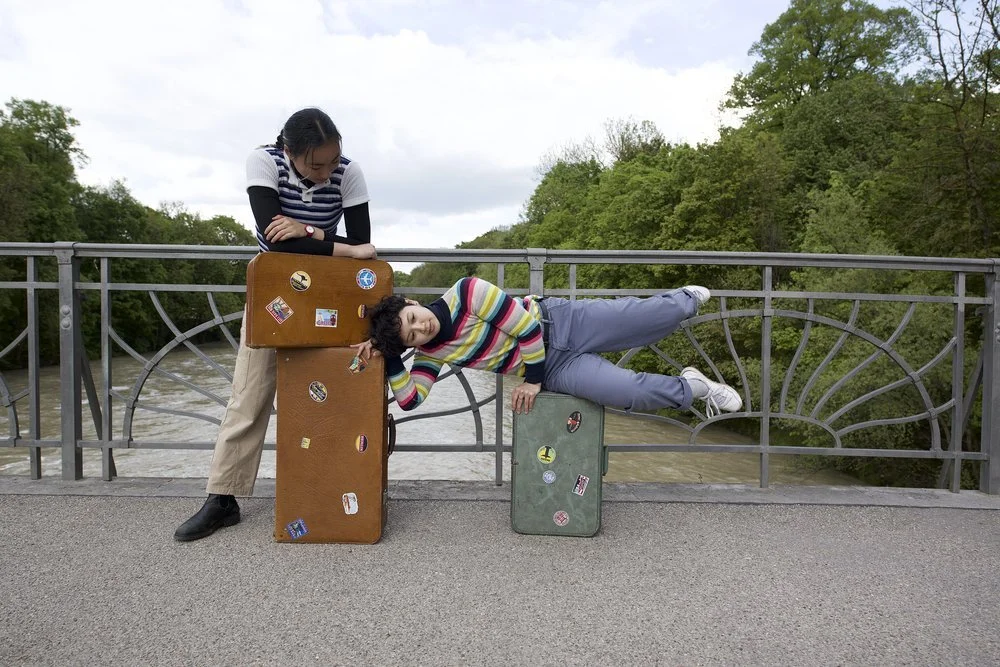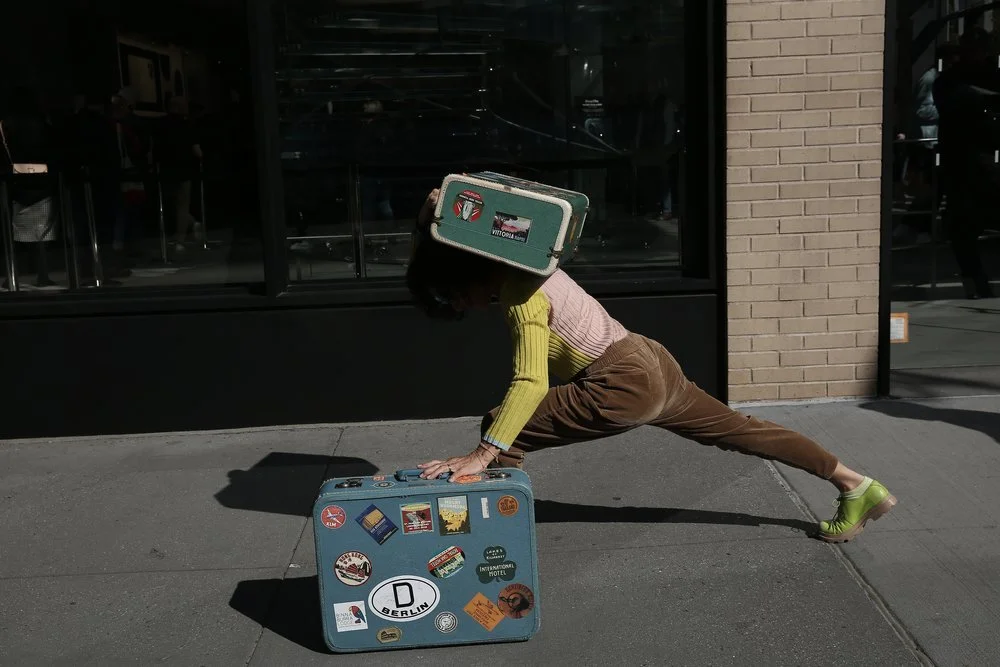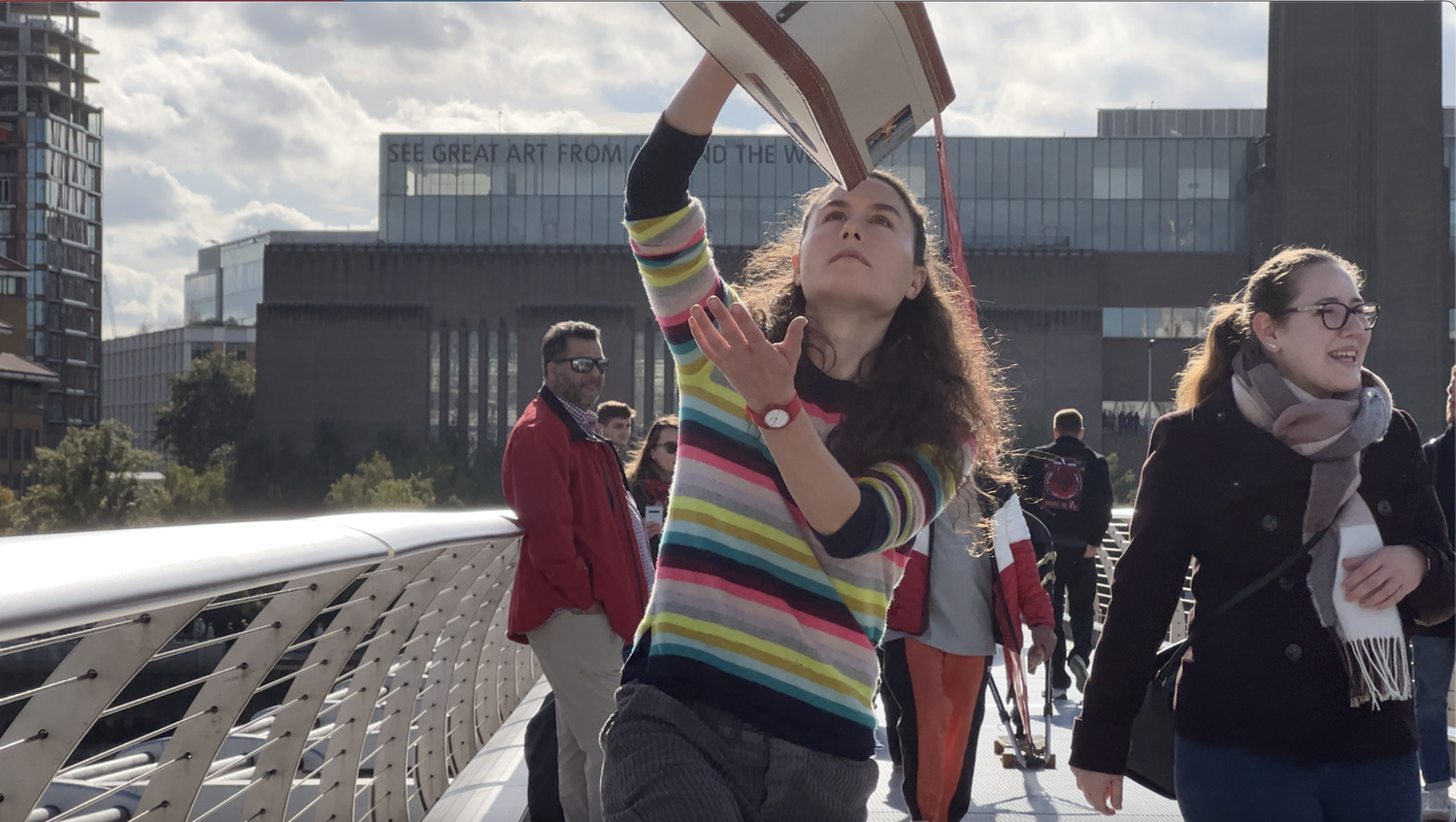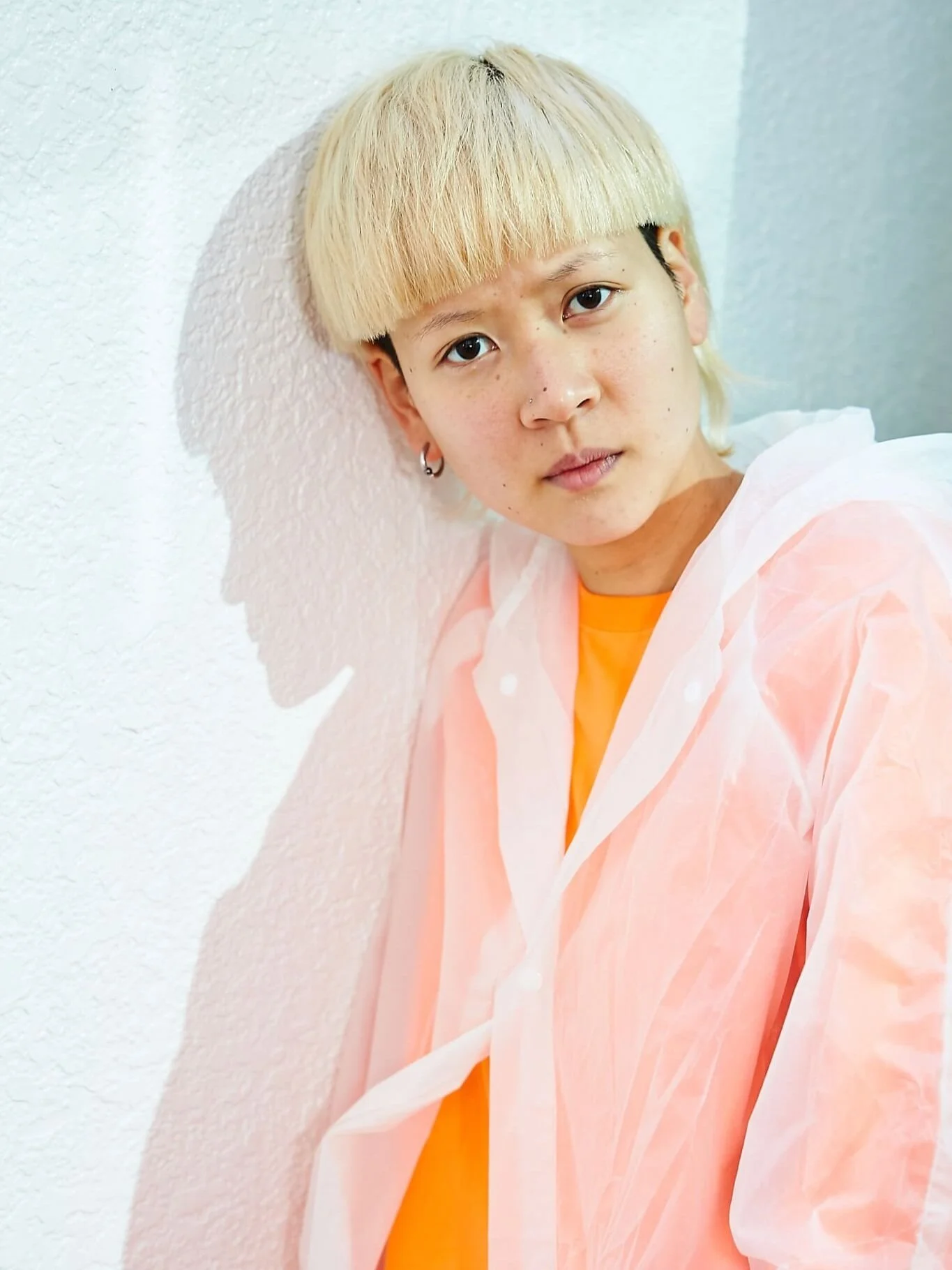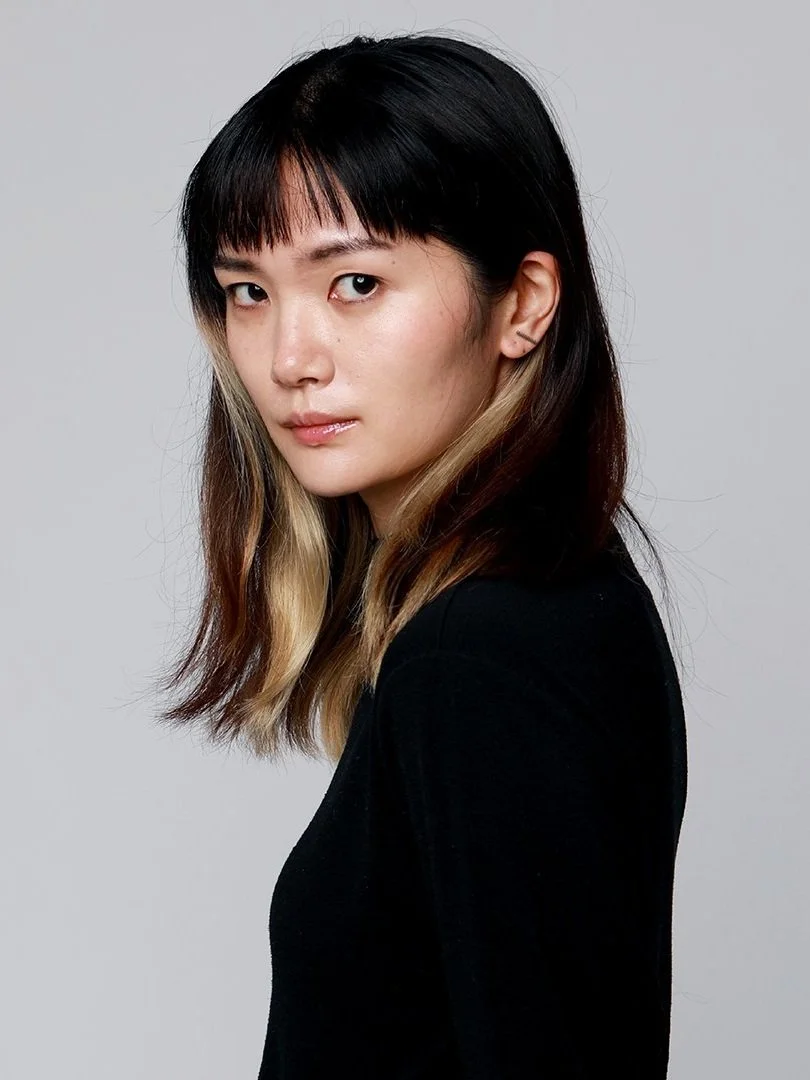Life Traveler / Jody Oberfelder
Interview by Ayae Takise
Photo: Dieter Hartwig
Through this conversation, we will explore with choreographer Jody Oberfelder and two dancers, Mei Yamanaka and Maya Takeda about their performance “Life Traveler“ that will take place on Shibuya Bridge, Tokyo.
—How did this interactive performance “Life Traveler” start initially?
Jody: First it premiered as a quartet at St. Pancras Station in 2018. Most later performances were done as a solo except for a few locations, and yes, it was before COVID-19 when there was no trouble getting close to the audience. It first became a performance of multiple performers at Munich in the Dance Munich Festival in 2023, where eight performers performed at eight bridges.
—Every performance takes place on a bridge. Why is this?
Jody: The performance itself is a metaphor of travelling. Bridges have a linear beginning, the middle, and the end. But a participant noted that “Life is not linear.” This quote remained in my memory, and made me think about the idea of traveling as a spectrum.
For instance, you plan where you are going to head while leaving a time or space for yourself for spontaneity and new ideas, expecting on a premise that you will change through it —then you realize that as you travel, you just have to let things come to you and develop a sense of being present, questioning yourself where you stand. You literally become a Life Traveler when you travel, and that’s the sort of the essence for this piece. It's philosophical as well as just seeing something out of the ordinary that may change your day.
During the performance at St.Pancras Station, some were dancing with preset choreography, others were getting in contact with the audience to dance together. The most stunning part was when we went up the escalator with one pedestrian and had a conversation looking down below, seeing all the people moving and traveling. The conversation became about the motion of everyone going in different directions and travelling. That was the strongest highlight of the performance, an interaction brought by the audience. It just extracts the idea of travelling through life.
Photo: Simon Burrill
—So the performers do not just deal with dance movements but communicate verbally with the pedestrians.
Jody: It's a very simple concept. We're walking with suitcases, move with them, then pause. During this time we can be as fancy and embellished with cool choreography or just simply walk around, stepping in different directions. The idea for the solo performer is to be in a complete mindset of “I am traveling”—Not to show off and perform, but to think, or just intuitively exist with your body and mind being in the moment, so that others understand it just by being around or observing the performer.
In the piece, performers are given a score on how to interact with the pedestrians or how to set their minds throughout the whole time. So there are three parts: First, inviting the pedestrians to move with them. Maybe the performer walks around a pedestrian before they engage, and hand them a suitcase if they seem to be okay “travelling” with the performer. If the pedestrian seems motivated to do cool things on their own, the performer starts out their movements.
Secondly, observe, witness, and contemplate. The performers pause and expand that moment for the pedestrians with language or movement. You know, when dancers are just holding an arabesque on stage, there is nothing else you're thinking about except for that move and the audience observes it from a distance. But once you share your movements and the space with a pedestrian, that moment will bring them to a fulfillment of body, space and time. That's our goal. Of course, Maya, Mei, Maho (appearance on Saturday) are extraordinary dancers worth watching. But the challenge as a performer is to make that accessible so that everybody feels part of it.
Lastly, we performers thank the pedestrian—the traveler—for traveling with us and give out a small souvenir.
Photo: Paula Court
—The pedestrians will encounter this situation in a spontaneous manner. I believe the Japanese, Tokyoite pedestrians in particular, may respond to this performance in a different manner compared to Western country people. What are your expectations and the challenge you find in it?
Jody: I'm just guessing ....today marks my fifth day at Osaka. People are very formal, polite and don't go out of their space. They allow energy to come to them whereas Americans, unfortunately, take up a lot of space. We expect a lot of people just to be “huge” like our country! I feel a certain subtlety baked into Japanese culture, just the way food is prepared and arranged. Rather than being piled in a bunch, everything is delicate and is very functional in a nice way.
So they may be more shy and insecure about joining in. I think the language—I mean the literal language, not just the dance language—has to be modified so that the invitation will not be seen as something forceful.
Still, I think people like to be taken out of their comfort zone a little bit. “Performance intervention” is a popular term to use when talking about a pop-up piece that changes a space, but I don’t prefer using this word for “Life Traveler”. I take intervention as something that forces the audience to be engaged to the performer, and shoves them aside at the same time. But I trust that people are potentially connected and strangers talking to you isn't much of a bizarre situation.
Anyways, I want to discuss this with Mei and Maya later on: When inviting the pedestrians to this experience I want to make sure people don't think I’m crazy or homeless because I have this old suitcase (laughs). How it becomes art is really a manifestation of the score.
—I also feel that every person has the potential to be open to the unknown. “Life Traveler” enlightens those parts of people, how they contact others.
Jody: It's exactly that—humanistic, yes. It’s very sad if you're walking around in a little shell and don't let other people penetrate your world, because we do travel through our life with many, many people from many cultures. Nobody is brought up the same way. We all have different experiences to bring us to this moment of presence. The importance is to pause and observe, embody the moment: So in a way, the passerby is our participant too, even if they don’t move with us but shift their focus away from their tasks or rushy minds while walking in the streets.
The relationship between the pedestrians and performers are like the two cups I have here.
—That makes perfect sense! So today we also have Mei and Maya here for the conversation.
Jody: I first met Mei when she was performing at a group show at New York. When we met in the restroom of the venue I told her immediately that I loved her performance and wanted to work with her. Later we worked together on my project “The Brain Piece” (*1) which was a piece for 15 dancers and also invited the audience onto the stage. I haven’t seen a dancer like Mei who would be so connected to the audience.
I have also worked with Maya on “Splash Dance” (*2) in London. She always is willing to learn, to explore, and contribute creatively. There were eight of us. We began the piece by coming up to people and asking them the simple question “Do you think we make a ripple in life?” Then when we began to wade in the fountain pool our disappearing marks evolved into an exuberant dance. The water was cold, but we had so much fun.
—Personally, I am convinced that Mei is participating in “Life Traveler” because she has been posting her improvisational dances on Instagram daily.
Jody: I admire Mei so much because her Instagram improvisations are part of her practice every day, even before everybody was doing it. Filming yourself, dancing in places to make people see the space the new way.
Mei:The short videos I usually post on Instagram—where I dance alone in different places or involve people around me in dancing—are closer to commemorative snapshots or video diaries than performances. “Life Traveler” may probably look similar, but since it has a performance duration of one to two hours, I believe it has a stronger performative quality. I think what shapes a performance is the sense that the performer gradually blends into the place over time and the opportunity to perceive subtle changes in the environment.
Post rehearsal play. Video Mei Yamanaka
Mei:As dancers, we use our bodies regularly, so I think we live our daily lives with an increased sensitivity to subtle things, like “Which direction is the wind blowing from right now?” After the pandemic settled and the world returned to its usual pace, information started to dominate even our daily lives. But if we focus more on our bodily sensations rather than receiving the scenery before our eyes as just information, the way we perceive things changes. I’m really happy when we can share a moment with passersby, where we pause for a bit, use our senses in a different way, and feel that place and that moment together.
I also think people in Japan—especially in Tokyo or other big cities—tend to close off their bodies and senses when in public spaces. In that sense, I felt New Yorkers often had a larger presence and more expressive reactions—good or bad—in complete contrast. Of course, in any country, there are people who are indifferent or scared, and others who are proactive, engage, and enjoy the interaction.
But suitcases alone are already lovely, as they evoke a person’s past or future just by being there. This time, we plan to put some care into the costumes and props as well to make them cute and charming. Some people might think, “There are some strange people dancing with suitcases who started talking to me,” (laughs) but I hope we can chat casually with anyone who feels like engaging.
—How about you, Maya?
Maya: To be honest, I think presenting this work in Shibuya will be a personal challenge for me. I’m originally from a small rural town called Nisshin City in Aichi Prefecture. Now I live in Suwon, South Korea, which is a fairly urban place, and I also lived in Tokyo for about seven years. But when I visited Tokyo recently, I felt a bit overwhelmed—the buildings were tall, there were so many people, the pace of cars and pedestrians was fast—and I found myself thinking, “This is such a big city!” Even though I was born and raised in Japan and used to live there, after living in different places, I realized I could now feel something entirely new toward a place I once called home. That was an unexpected discovery.
So I think in this performance, I’ll be facing the city of Shibuya with fresh eyes, engaging closely with the place and the people passing by, and taking time to explore how I relate to them through the work. I hope to find lots of options at the moment.
—So usually in daily life, when you interact with strangers or in a very alien situation, how would you deal with them/it? How would you communicate with them?
Maya: I try to listen, listen, and feel my own sensation as well to stand on the same ground with others.
When communicating with others, I think that if you bring too much intensity, it can sometimes come across as aggressiveness. I'm not always very skilled at communication, so I sometimes feel pressured—like I have to keep talking or I have to take the lead. But I think there are times when that urgency might not be received well by the other person.
—It’s a question of power balance.
Jody: When I was shopping along the arcades at Osaka, people were standing by their shops and shouting, “Come inside, buy my thing!” Yes it was too aggressive. In the performance, it's the other way around—the dancers moving with grace and technical ability is accessible and should inspire the pedestrians’ intuition, letting them realize that they are also a mover, a life traveler. too. They are “with” the dancers’ with ideas and movements, with conversation in-between.
Photo: Paula Court
—So the question arises of performing arts as a form of art being very theater-based. In my opinion—if I were to think about it critically—while it is aimed to be open to the public, it still has a certain disconnection to the actual “public,” and it allows the general audience to feel objective and distant about the same human bodies seen on stage. “Life Traveler” and other works done by you, Jody, serve as a counter to this at some point. Engaging the audience to reflect the dancer’s body to an everyday-ordinary level to themselves, is a key for the future of performing arts.
Jody: The question of live performance, gathering people to experience the same subject, has been going on forever. Theatrical dance has a place. I think everybody's minds are too busy right now. We have so much media coming at us that it's harder for people to concentrate and get out of their regular way of things. Why the fourth wall?
I think the keyword is engagement. How many levels can “Life Traveler” engage people? Pedestrians on the bridge may likely be on their phone, texting, and even if they’d pause a while to watch us, they would go back to texting. Still, I still take those few seconds of watching as participation.
One of the lines we have prepared is “Do you think with every step we move into the future?” Sometimes people don’t respond by speaking, they may reflect it inside, or the unspoken is the response. I think that's where the reality lies.
Photo: Simon Burrill
—Life Traveler is very essential. We need these kinds of perspectives, consciousness to body and time and space, and it is a true honor for me to introduce, or translate these works to the Japanese audience.
Jody: And what we need is a community of people. We are the human art form, not separate from each other. You have a body, I have a body, so we share. I like this idea of translation—some people don't know how to look at dance. They look at it like the Olympics going “Wow, wow!” but they don't realize that all humans are playing with time and space and form. I'm hungry for that kind of art myself, something that touches me. I think art has been around since the beginning of time because people are expressive and need some language of understanding that's beyond day-to-day.
I also want to say that we don't want to get too precious with our art. I don't want to say “We're artists and we see the world differently than you,” I think art is a way of making sense of the world. It really is.
*1: Presented June 28-July 1 2017, at New York Live Arts, NYC
*2: Premiered at Victoria and Albert Museum in the John Madejski Garden on April 23, 2022 as part of the V & A's Performing Arts Festival London
Photo: Ashton Bisner
Jody Oberfelder is a New York-based director, choreographer, and filmmaker whose work explores how dance can illuminate life. She creates immersive, site-specific performances across stage, film, and public spaces—ranging from train stations and cemeteries to historic landmarks and city bridges. Her work invites audiences into intimate, participatory experiences.
Recent projects include And Then, Now at Green-Wood Cemetery, Walking to Present (commissioned by Dance München and Brooklyn institutions), Splash Dance at London’s V&A Museum, and Life Traveler, performed in cities such as Düsseldorf, Amsterdam, and London. Other notable works include Story Time, Monument, 4Chambers, Madame Ovary, and collaborative or commissioned pieces with orchestras and art institutions like the Brooklyn Philharmonic and the Kurt Weill Foundation.
Oberfelder has also produced over 20 dance films, including Dance of the Neurons, Come, Sit Stay, and Duet, created when she was eight months pregnant, *cited in the 2024 book Becomings, Pregnancy, Phenomenology, and Post Modern Dance by Joanna Kirk, shown at international festivals and conferences. Commercially, she has choreographed for brands like Versace, Prada, Guerlain, and Danskin. Her company has been supported by organizations including New Music USA, the Harkness Foundation, NYC’s Department of Cultural Affairs, and the National Endowment for the Arts.
Photo: Shuhei Kishimoto
Mei Yamanaka is a dancer and choreographer from Tokyo, Japan. She began studying classical ballet when she was 6 years old and began studying hip hop at age 16. At age 18, she added modern and contemporary dance styles. In 2008, at the age of 18, she moved to New York City.
Her choreography has been presented in Japan and the United States. She has worked and collaborated with artists including Tiffany Mills Company, Jennifer Archibald, Dendy Donovan Projects, Katy Pyle/Ballez, Jody Oberfelder Project, Patricia Noworol Dance Theater, Dai Jian, Palissimo, Oui Danse, Malcolm Low, Jenni Hong, Emily Berry, White Wave Dance Company, Catherine Galasso, Christine Bonansea, Boy Friday, Kensaku Shinohara, and Orange Grove Dance, among others. In 2014, she was awarded the best dancer from Italian International Dance Festival.
In 2020 she relocated to her hometown, Tokyo and has kept active as a dancer and choreographer.
Maya Takeda is a dancer born in Aichi Prefecture. She began training in classical ballet and modern dance at the age of seven under Emi Sugiki and Megumi Sugiki. In March 2012, she was awarded a 10-Year Certification of Completion by the Japan Contemporary Dance Association (Public Interest Incorporated Association). In April 2013, she entered the Department of Physical Education, Dance Studies Major, at Japan Women’s College of Physical Education. While in school, she was primarily active in the Modern Dance Club and participated in events such as the All Japan Dance Festival in Kobe and the Kanto Student Dance Federation Recital. She entered the graduate program of Japan Women’s College of Physical Education in April 2017. Since September 2016, she has been a member of Nect. Finalist of Yokohama Dance Collection 2024.
Life Traveler 2025 Tokyo
At Shibuya Bridge, Tokyo (near Shibuya Station West Exit) Google Map
Saturday, July 19th from 8-9:30 pm
Sunday, July 20th from 9:30-11 am
Life Traveler is an interactive piece performed on bridges. Since 2018, we have traveled to Munich, London, Düsseldorf, Minneapolis, Amsterdam, NYC, Philadelphia, Portland Oregon, Berlin, and Frankfurt. Dancers tote and dance with vintage suitcases, passing one along to someone crossing the bridge and we travel together. In this moment we offer an invitation to contemplate the present moment, age, history, and journey. The goal is to give the audience a one-on-one embodied experience, connecting with the space around you, to notice the ordinary and extraordinary in the midst of traveling through our lives, a chance to pause and reflect on presence while traversing a bridge
Life Traveler’s theatricity lies in its simplicity. The dancers, with interactive conversation, both physically and verbally, “wake up” the present moment. Those passing by become a part of an enhanced moving experience. Shall we travel?


